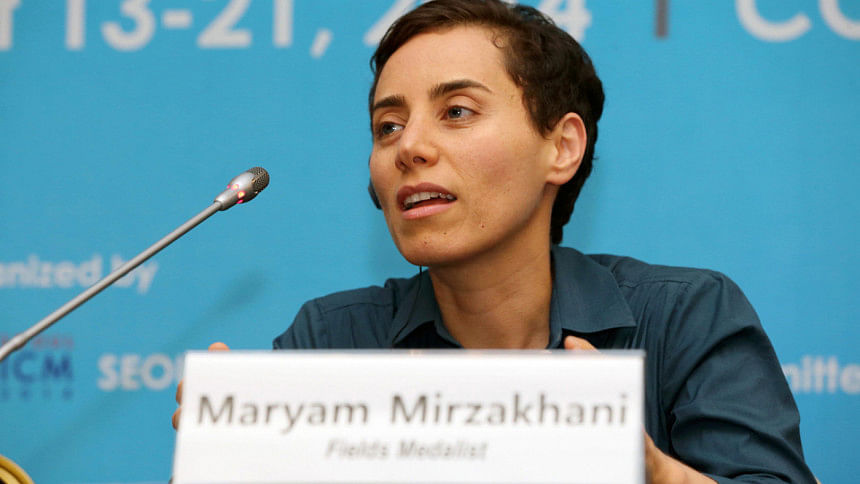A tribute to the life and legacy of Maryam Mirzakhani

The second death anniversary of Iranian mathematician Maryam Mirzakhani has passed quietly early this week. Not many people in Bangladesh are probably familiar with the work of this mathematics genius, but globally, she is held in high regard because of her ground-breaking work. For those who do not know, Maryam Mirzakhani was the only female mathematician to have won a Fields Medal, the most prestigious award in mathematics, often described as the Nobel Prize for this subject.
Maryam was born in 1977 in Tehran, Iran, and worked as a professor of mathematics at Stanford University, USA, before dying of cancer on July 14, 2017— at the age of 40. Her death was viewed as a great blow to mathematics and the mathematical community and a great loss for humankind. Her date of birth, May 12, was proposed as the "International Women in Mathematics Day". Satellogic launched a miniaturised satellite into space on February 2, 2018 in honour of her memory. When she died, the whole world mourned her passing, the Iranian media covered it extensively, and published her picture without hijab, which would have been unthinkable under normal circumstances.
Maryam was a two-time gold medallist at the Math Olympiad, in 1994-95. She obtained her PhD at Harvard in 2004. Not to mention, as an Iranian citizen, she had to overcome barriers to join an Ivy League university. Her dissertation was a masterpiece. As another great mathematician described it— "the majority of mathematicians will never produce something as good,". In that, Maryam solved two longstanding problems. Each of the problems was significant on its own merits but she combined the two and presented their solutions in one thesis paper. Out of this thesis emerged papers that would later be published in top three mathematics journals.
Maryam contributed in areas such as Teichmuller theory, hyperbolic geometry, ergodic theory, symplectic geometry, etc. Her thesis showed how to compute the Weil-Petersson volumes of moduli spaces of bordered Riemann surfaces. The simplest way to explain her work would be to say that she proved many amazing theorems about the shortest paths between two points—called "geodesics"—on curved surfaces, among other remarkable achievements in geometry and beyond. Her work was highly theoretical in nature, but it left a deep mark on theoretical physics, especially about how the universe came to exist, and—because it could inform quantum field theory—on secondary applications to engineering and material science. Within the mathematical field, it has implications for the study of prime numbers and cryptography.
Maryam's untimely death, therefore, was one of the saddest losses in the field of mathematics. One of her colleagues mourned her death saying, "a light was turned off today, it breaks my heart…. Gone far too soon." Another described her legacy by saying, "Maryam is gone far too soon, but her impact will live on for the thousands of women she inspired to pursue math and science." Her friends praised her as a great scientist who attempted to solve a problem that was not solved before, to understand what was not understood before. She was driven by a deep intellectual curiosity. Any success brought her pure and simple joy.
She was a gentle, humble person and a great teacher as well as a supervisor. Maryam once said, in a rare interview: "I can see that without being excited, mathematics can look pointless and cold. The beauty of mathematics only shows itself to more patient followers." She was known to her colleagues as "a virtuoso in the dynamics and geometry of complex surfaces" but to her 6-year-old daughter, she was "something of an artist" who used to draw things on paper for hours in an enthusiastic attempt to discover formula that can describe the complexities of curved surfaces.
During her final years, she collaborated with another mathematician to search the answer for a mathematical challenge that physicists have struggled with for a century—"the trajectory of a billiard ball around a polygonal table." Her extraordinary work in this regard was explained thus—"she considers not just one billiard table, but the universe of all possible billiard tables. And the kind of dynamics she studies doesn't directly concern the motion of the billiards on the table, but instead a transformation of the billiard table itself, which is changing its shape in a rule-governed way; if you like, the table itself moves like a strange planet around the universe of all possible tables..." That investigation led to a paper, immeasurably valuable in the field of mathematics, which came close to explaining the complexities of "string theory"—the complexity of how the universe is expanding and functioning seemingly without any collusion. May be, just maybe, the world lost a female Einstein in the making.
Maryam will inspire generations of mathematicians to come, particularly female. She could foresee that too, as she said in her speech while receiving the Fields Medal—"This is a great honour. I will be happy if it encourages young female scientists and mathematicians. I am sure there will be many more women winning this kind of award in coming years."
Let us pay our respects to Maryam Mirzakhani and learn from her extraordinary life and work.
ASM Shahidul Haque is a development worker. Email: [email protected]

 For all latest news, follow The Daily Star's Google News channel.
For all latest news, follow The Daily Star's Google News channel. 



Comments